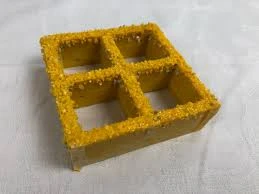loading...
- No. 9, Xingyuan South Street, Dongwaihuan Road, Zaoqiang County, Hengshui, Hebei, China
- admin@zjcomposites.com
- +86 15097380338
- Welcome to visit our website!
Innovative Solutions for Lightweight FRP Stair Design and Installation Techniques
The Innovative World of FRP Stairs
In the realm of modern construction and architecture, the use of advanced materials has transformed the way we approach design and functionality. One such material that has gained considerable attention is Fiber Reinforced Polymer (FRP). Among its myriad applications, FRP is increasingly being utilized in the creation of stairs, offering a blend of durability, lightweight properties, and aesthetic appeal that traditional materials cannot match.
What is FRP?
Fiber Reinforced Polymer (FRP) is a composite material made from a polymer matrix reinforced with fibers. These fibers can be glass, carbon, or aramid, providing the composite with strength and resistance to various environmental factors. The unique properties of FRP make it suitable for a wide range of applications, from aerospace to automotive parts, and increasingly, to construction materials like stairs.
Advantages of FRP Stairs
One of the most significant advantages of FRP stairs is their lightweight nature. Traditional materials like concrete or steel can be heavy and cumbersome, often requiring additional structural support. In contrast, FRP stairs are much lighter, which can reduce the overall weight of the structure. This lightweight characteristic not only eases transportation and installation but also minimizes the structural support needed, making it an efficient choice for many types of buildings.
Another crucial benefit of FRP stairs is their remarkable durability. FRP is resistant to corrosion, moisture, and chemical exposure, which is particularly advantageous in environments that experience extreme weather conditions or exposure to harsh chemicals. This means that FRP stairs can maintain their structural integrity and appearance for longer periods, reducing maintenance costs and extending their lifespan significantly compared to traditional materials.
Moreover, FRP stairs offer excellent slip resistance, thanks to their customizable surface textures. This feature makes them particularly suitable for outdoor applications or areas prone to spills and moisture, enhancing safety for users. The safety aspect is not to be overlooked, especially in commercial settings where foot traffic is high.
frp stair

Aesthetic Versatility
Beyond functionality, FRP stairs can also be tailored to meet diverse aesthetic preferences. Manufacturers can produce FRP in a variety of colors, finishes, and designs, allowing architects and designers to get creative without sacrificing performance. This aesthetic flexibility means that FRP stairs can seamlessly blend into various architectural styles, from modern and minimalist to more traditional looks.
Environmental Considerations
In today's eco-conscious world, the choice of materials plays a crucial role in sustainability. FRP is often favored for its lower environmental impact during manufacturing compared to traditional options. Many FRP products are made from recycled materials, and their long lifespan contributes to reducing the frequency of replacements, promoting a more sustainable approach to construction.
Applications of FRP Stairs
FRP stairs are suitable for a broad spectrum of applications. In industrial settings, they are commonly used in factories and warehouses where durability and resistance to chemicals are paramount. In commercial environments, their slip-resistant properties make them ideal for shopping malls, offices, and public buildings. Additionally, FRP stairs are gaining traction in residential design, particularly in outdoor decks and poolsides where water resistance is critical.
Conclusion
As the demands of construction evolve, so too do the materials we use. FRP stairs represent the forefront of this evolution, marrying cutting-edge technology with practical benefits. With their lightweight nature, exceptional durability, aesthetic versatility, and safety features, FRP stairs are positioned to redefine how we think about stair design in both commercial and residential settings. As we move toward a more sustainable future, the increased adoption of innovative materials like FRP will undoubtedly play a vital role in shaping the architecture of tomorrow. The world of FRP stairs is just beginning to unfold, promising exciting possibilities for builders and designers alike.
-
The Rise of FRP Profiles: Strong, Lightweight, and Built to LastNewsJul.14,2025
-
SMC Panel Tanks: A Modern Water Storage Solution for All EnvironmentsNewsJul.14,2025
-
GRP Grating: A Modern Solution for Safe and Durable Access SystemsNewsJul.14,2025
-
Galvanized Steel Water Tanks: Durable, Reliable, and Ready for UseNewsJul.14,2025
-
FRP Mini Mesh Grating: The Safer, Smarter Flooring SolutionNewsJul.14,2025
-
Exploring FRP Vessels: Durable Solutions for Modern Fluid HandlingNewsJul.14,2025
-
GRP Structures: The Future of Lightweight, High-Performance EngineeringNewsJun.20,2025
